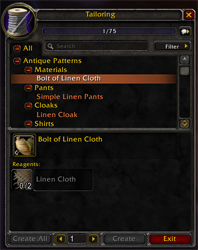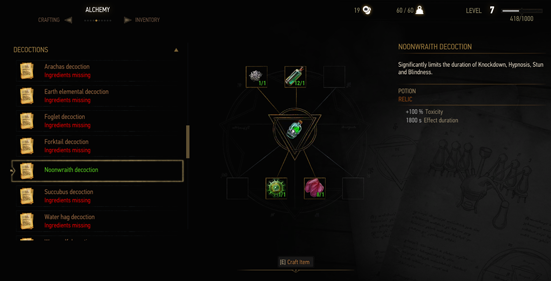Crafting - Overview
|
|
Lately I've been thinking about how crafting should work in my game. There are so many options to consider that it's a bit overwhelming to start from scratch. Rather than stumble around blindly I figured I'd take a look at how some of my favorite games have designed their crafting systems.
I'll be examining World of Warcraft (both pre and post warlords), Guild Wars 2, Minecraft (primarily vanilla, perhaps some modded), and The Witcher 3. I'm planning to cover these topics over the next week or two:
- Overview of Systems
- Material Acquisition & Diversity of Materials
- Improving the Skill & Gating Mechanics
- Permanence & Usefulness
- Opinions and Lessons Learned
With that said, let's jump into the overview.
World of Warcraft

I'll be discussing both WoW traditionally as well as the changes brought in with Warlord of Draenor since crafting has been changed pretty radically with the expansion.
WoW's crafting formula for each expansion prior to Warlords was:
- Learn trade skill and initial skills from trainer
- Gather first tier of materials
- Craft some number of low level items to increase skill
- Repeat with next tier of materials until max level
Crafting can be accessed through the player’s spell book from anywhere in the world. Some professions require a specific location (forge, anvil) to craft but many can be done anywhere.
Once at max crafting players could acquire recipes from reputation vendors and other sources which would teach them how to craft items that actually had some late game value. In Warlords much of the initial leveling procedure is the same, however end game crafted has been almost entirely integrated in the garrison system.
One of the benefits of this system is its approachability. Once a player has invested time leveling through the first tier they pretty much understand exactly what they need to do for the rest of the way. Unfortunately this also means that the system has a lot of repetition and can quickly become tedious. This tedium has been emphasized in Warlords as what nuance the system did have at max level previously has been largely removed. Each profession was given a largely universal currency which buys new recipes, is the sole material for crafting most of these recipes, and is locked to a fixed amount that can be created each day.
Guild Wars 2

GW2 follows many of the same conventions as WoW. Player's still learn a trade skill, craft a bunch of low level items to skill up and repeat this process until they've capped their crafting skill. One new feature that Guild Wars added was the discovery mechanic. The default leveling recipes tend to be for components which can be combined into complete items rather than the items themselves. For example to level tailoring you can craft shoe soles, shoe uppers, and an insignia to specify the stats you want, then in the discovery panel you combine these items for a pair of boots and a large chunk of experience.
Known crafting recipes can be viewed in the hero panel from anywhere, however every profession has a work station that is required to actually create items.
When the game was first released, discovery was a great way to keep things interesting while leveling and it definitely felt cool finding something new you could make. As the game has aged users have documented recipes and learned how to optimize leveling. As such crafting is largely a bland experience for veteran players.
Minecraft

Minecraft's crafting involves arranging a series of items in a 3x3 (or 2x2) grid to form a representation of the item you want to create. Other methods of crafting are combining raw ore and a fuel source in a furnace as well as combining experience, a weapon, and lapis lazuli into an enchanted weapon.
Players are able to craft any number of items that require a small grid at any time, but must use a crafting table for items with a larger crafting footprint.
In some sense you could consider building a castle or laying out a redstone device as a form of crafting as you are assembling a game entity from a set of components, however I've made the assumption that building is distinct from crafting for the sake of simplicity.
The concept of discovering recipes through experimentation is interesting, however in Minecraft's case I feel it doesn't provide enough in game help nor is it intuitive enough. The community has taken it upon themselves to create a comprehensive list of recipes because frankly, a new player on their own will have a hell of a time figuring out how to craft.
Witcher 3

The Witcher allows players to craft potions and bombs themselves and leaves blacksmithing to vendors. Crafting requires a wide variety of materials as well as a recipe. Recipes for basic goods can be bought from merchants and rare items can be crafted by finding their recipe hidden in various locations throughout the world. There are tiers of blacksmiths which can craft progressively better equipment as the player progresses enough to find them.
This system rewards exploration heavily, with rare materials and patterns coming from monsters and dungeons. The downside of this system is that the player's inventory can become cluttered and hard to manage with the sheer number of different items they will collect.
Conclusion
So there we have it. Four games, four takes on crafting. Next time I'll discuss how materials are acquired and material diversity in each of these games.